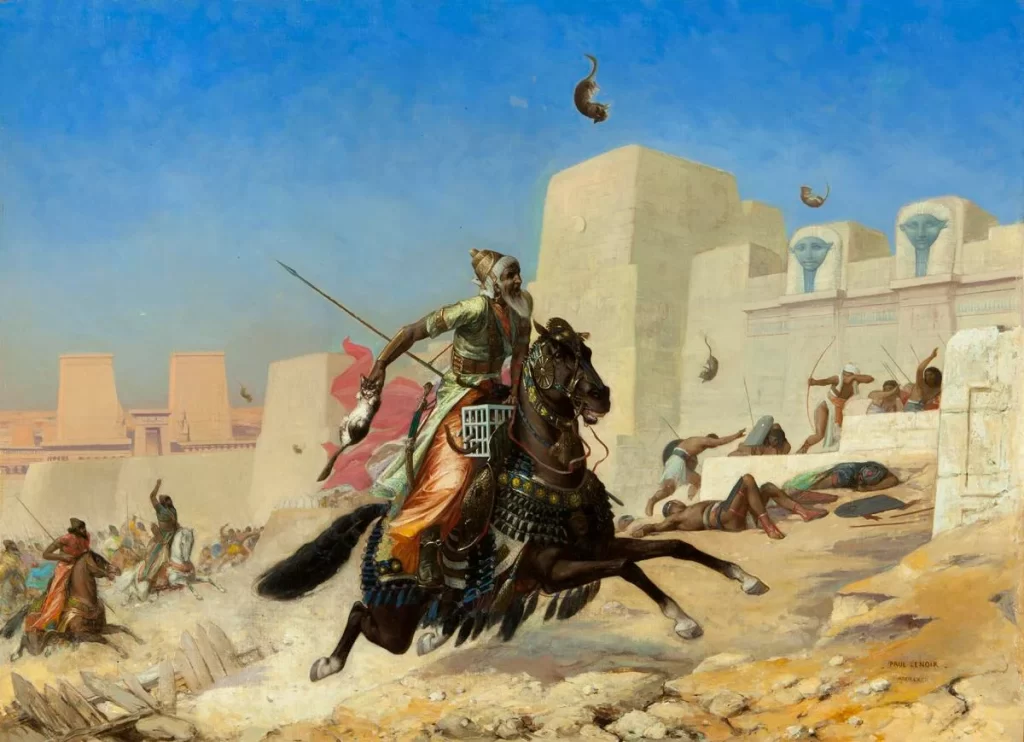
The Battle of Pelusium
[ez-toc]
Overview of Historical Background about the Battle of Pelusium
The battle of Pelusium, fought between the Achaemenid Empire (the First Persian Empire) led by “Cambyses II” (525-522 BCE) and the ancient Egyptian empire led by “Pharaoh Psametik III” (526-525 BCE), was one of many conflicts that altered the course of history. This conflict was brought about by the foolish and aggravating actions of “Pharaoh Amasis II,” the father of Psametik III. The throne of the pharaohs was passed to Cambyses II of Persia as a result of the battle of Pelusium, which had a significant impact on the future of the kingdom. The Persian army prevailed in this conflict thanks to its commander’s understanding of Egyptian culture and his employment of unconventional hostage-taking tactics—cats.
Battle of Pelusium Reasons
One of the main reasons for the battle is that when King Cambyses asked Amasis’s daughter for marriage, he didn’t want to lose her to a Persian who was thought to be less powerful than an Egyptian even though he was a king so instead, he sent another girl named “Nitetis” to take her place and pretended to be his daughter and the future wife of Cambyses but when she stood in front of him, she revealed Asami’s wickedness and trickery.
The Catastrophic Diplomatic Relations of Amasia II
As “Phanes of Halicarnassus” fled to Persia and helped the Persian king’s army in their conquest in all manners of strategy and tactics and was the true mastermind in the defeat of Egypt, which he told him about the Egyptian religions, Amasia II’s resentment toward the wise councilman, mercenary, and tactician made “Phanes” into his worst enemy. Amasia II had a horrible propensity for making enemies and developing a bad rapport with his neighbors, such as the king of Arabia who gave the Cambyses army safe access and provided him with men, which made it easier for the empire of Egypt to be completely destroyed. Amasis passed away six months before Cambyses arrived in Egypt, leaving his son “Psamtik,” who hoped to save his country, entirely dependent on his army and his scant military knowledge as all of Egypt’s allies, including the Greek forces, Polycrates of Samos’ massive fleet, and Phineus of Halicarnassus, Egypt’s most prominent tactical advisor, switched to the Persian side.
The Genius Strategy of the Persian Army to Win the Battle
According to Herodotus, the Battle of Pelusium was a Very Special Battle because it was an Early Form of Psychological Warfare (a Greek historian). The Persians had a brilliant strategy to take use of the Egyptians’ strong religious beliefs against them. They attacked while placing cats in front of them, and the Egyptians were too afraid to shoot an arrow or even attack in any way for fear of hurting the cats. This tactic was based on the notion that ancient Egyptians worshipped the goddess Bastet (the cat goddess of beauty, protection, the home, and fertility). At the time, Bastet was the most powerful and revered deity in Egypt, and as a result, casts were protected and held in high regard because killing a cat resulted in death and eternal damnation. As a result, the Egyptians lost the city of Pelusium. The Persians only lost 7,000 troops, but the Egyptians lost 50,000, and the Egyptians withdrew to the city of Memphis. Psamtik was forced to give up the city and live under the rule of the Persian monarch when Cambyses led his men to Memphis and defeated the surviving army. Psamtik was eventually put to death when he sought to overthrow the Persian Empire.
The Aftermath of the Battle
Before Alexander the Great’s army arrived and conquered the area in 331 BCE, the Persians would rule Egypt as an independent nation for roughly two hundred years during the 27th and 31st dynasties. Egypt would then be ruled by a Greek monarchy until it was acquired by the Roman kingdom in 30 BCE.



